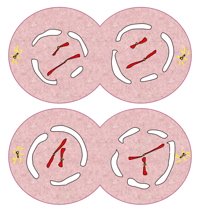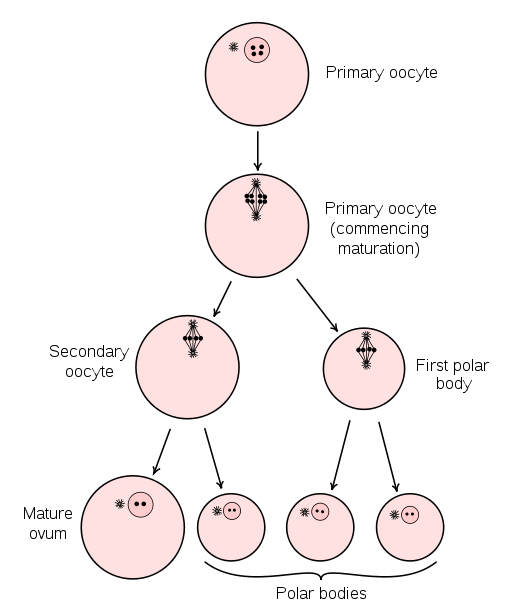Telophase II
Stages of Meiosis
|
|
EUGENE M. MCCARTHY, PHD GENETICS
| < | Mitosis | Meiosis | > |

|
During telophase II, the fourth step of meiosis II, the chromosomes reach opposite poles, cytokinesis occurs, the two cells produced by meiosis I divide to form four haploid daughter cells, and nuclear envelopes (white in the diagram at right) form. When telophase II is over, the two cells are entirely separated and their nuclear membranes are fully formed. Meiosis is then complete.
With sperms cells, though meiosis is complete and four separate germ cells (spermatozoa) have been produced from an initial primary spermatocyte, further maturation must occur before the spermatozoa are functional, a process known as capacitation during which the region of the acrosomal cap is altered so that the spermatozoon can participate in the acrosome reaction. There is also a maturation process before meiosis in which the spermatogonium is transformed into a primary spermatocyte. Issues specifically relevant to oogenesis are discussed below.
Compare to telophase of mitosis >>
Note: Meiosis II is very similar to mitosis.
| Etymology: The prefix telo- is from the Greek word telos, meaning end or completion. Some other common bio terms starting with this prefix are: telocentric chromosome, telomerase, and telomere. |
| The equator and poles: In explaining mitosis and meiosis, biologists use use a geographic analogy. Just as there is no visible equator in Brazil or the Congo, nor an x marking the spot at the earthly poles in the Arctic or Antarctic, there is no visible structure corresponding to the equator and poles of a cell. Equator is just the term used to explain where the chromosomes line up during metaphase and the poles are just the two ends of the cell where the centrioles migrate to before the chromosomes do. But don't expect to see anything at the poles of cell, no more than you would if you went to the poles of Planet Earth. |
| Oogenesis: During the production of eggs, meiosis begins with a primary oocyte, just as spermatogenesis begins with a primary spermatocyte. And there are two successive divisions. However, one of the two cells produced from each of those divisions typically (in mammals) degenerates. So that from one primary oocyte a single ovum is produced (see diagram of oogenesis immediately below). |

|
| Oogenesis |
Telophase II - Stages of Meiosis - Online Biology Dictionary - © Macroevolution.net - All rights reserved. Safe for kids!
Most shared on Macroevolution.net:
Human Origins: Are we hybrids?
On the Origins of New Forms of Life
Mammalian Hybrids
Cat-rabbit Hybrids: Fact or fiction?
Famous Biologists
Dog-cow Hybrids
Georges Cuvier: A Biography
Prothero: A Rebuttal
Branches of Biology
Dog-fox Hybrids